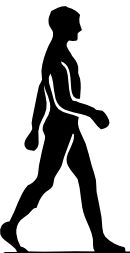Whether you are a professional or play sport just for fun, the demands made on your feet and lower limbs can lead to a range of injuries, including blisters, sprained ankles, torn ligaments, shin splints, knee pain, low back pain and other joint/muscle problems. There’s also common complaints such as corns, callous and athlete’s foot. Asking too much of your joints and muscles can lead to injury.
When we run, our body weight is multiplied up to three times, with our feet bearing the brunt of the stress at every stride (over 1,000 strides per mile, per foot). An 11 stone man of average size will process 112 tons of weight through each limb per mile.
 Mechanics of walking
Mechanics of walking
With each step, the vertical axis of the heel should land almost perpendicular to the ground, with a slight inclination of only a few degrees toward the outside of the heel. From there, the weight is distributed progressively toward the lateral (outside) side of the foot. As the little toe starts to touch the ground, the arch of the foot should flatten slightly, shifting the body’s weight toward the medial (inside) side of the foot. The heel then should start to lift off the ground, shifting the weight to the medial forefoot.
This is a complex process in which many things can go wrong. If a structural problem is present, the foot can collapse under the body’s weight creating more severe injuries, such as sprained ankles, shin splints and even fractures. Over time, stresses on the feet can deform them. One of the foot’s main functions is to absorb shock as the body’s weight shifts with each step. It does this through a complex process in which the arch of the foot flattens slightly. This absorbs and distributes the weight throughout the entire foot.
Highly Arched (Cavus) Foot
A person with a high arch, called a cavus foot – the arch does not flatten, it absorbs shock poorly. Instead of spreading it throughout the entire foot, the weight of the body falls only on the heel and the bases of the toes. This increases stress on the foot, especially the heel. Furthermore, because the weight is not absorbed well in the foot, it radiates up the leg to other joints. Over time, this can cause pain in the knees, hips and lower back.
To correct this condition, an orthotic is used to bring the ground into even contact with the rest of the foot. This allows the entire foot to support the weight of the body. Extra cushioning can be built into the orthotic so that some of the force does not even reach the foot.
Flat (Planus) Foot
A person with a low/flattened arch, called a planus foot – the arch flattens too much.. In such cases, the weight distribution on the foot is too far on the medial side. The foot appears to roll inwards – a condition called pronation. A flat foot is unstable and cannot maintain a proper arch. Over time, the weight of the body on an unstable foot will cause the bones of the foot to become misaligned. This can lead to the development bunions, hammertoes and other foot deformities, as well as knee, hip and lower back pain.
To address this problem, an orthotic with an increased arch will be prescribed to distribute the weight laterally. Depending on shape of the foot, the heel of the orthotic can be slanted to shift the weight more toward the center of the heel.
At Leyton foot clinic, we have the experience and expertise to assist with any form of sports related injury to your feet and lower limbs. With The introduction of the Advanced Laser Orthotic Technology for making medically prescribed orthotics, we are able to treat a wide range of problems more effectively. For further information or to book a consultation, please contact us. We’ll be only too glad to help.
Leyton Foot Clinic – Your feet come first!
